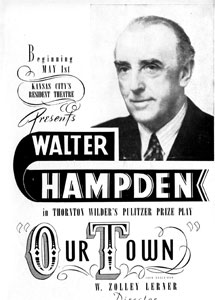 The early 1930s marked a tremendous output for the growth of the arts and culture in Kansas City. In October 1933 the University of Kansas City opened. One month late, Karl Krueger and the Kansas City Philharmonic performed their first concert. The very next month the William Rockhill Nelson Gallery of Art and the Atkins Museum opened their doors to present their world class collection of art.
The early 1930s marked a tremendous output for the growth of the arts and culture in Kansas City. In October 1933 the University of Kansas City opened. One month late, Karl Krueger and the Kansas City Philharmonic performed their first concert. The very next month the William Rockhill Nelson Gallery of Art and the Atkins Museum opened their doors to present their world class collection of art.
However, before any of these institutions, there was The Resident Theatre of the Jewish Community Center, Kansas City’s oldest community theater. Holding its first performance in 1932, the Resident Theatre would continue for the next 50 years and be recognized as one of the best community theaters in the United States.
Richard Piland’s new book, “The Illustrated History of the Resident Theatre Kansas City, Missouri 1932-1983,” chronicles this piece of Kansas City and Jewish history. The book features pictures and descriptions of almost all of the major productions the theater offered.
“The Resident Theatre was monumental for theater in Kansas City during the ‘40s, ‘50s and ‘60s,” said Piland, who describes himself as an amateur historian. “It was one of the best community theaters in the country.”
Piland self-published the book. It can be purchased by contacting him at . A CD version of the manuscript is also available.
This book is a result of more than 40 years of research, growing out of work Piland began while attending Central Missouri State College (now the University of Central Missouri). He was writing his master’s thesis and enlisted the help of several members of the Jewish community at that time, including Max Bretton, who was once the executive director of the Young Men’s and Young Women’s Hebrew Association, and Sol Margolin, who served as executive director of the JCC.
As Piland writes in the book’s preface, “Sadly, nearly all of the Resident’s archival records were lost or destroyed.” So he went to the directors, actors and reviewers to gather information and pictures on the productions. Once again he sought help from the Jewish community, where he was given access to souvenir programs, newspaper clippings, scrapbooks and other memorabilia.
“While I was doing my research I met some interesting, fascinating people,” Piland said. “And the feedback from those people when they see the book has been quite good. They say it brings back a lot of memories.”
What Piland’s research told him was that this was a sophisticated theater company.
“Within six months of their debut, they were staging successful Broadway shows, and were even able to recreate the Broadway sets,” Piland said. “And it’s most impressive all of the great actors that came out of there.”
Piland said some of the most famous plays in American history were first performed for local audiences at the Resident Theatre. Out of the 210 plays the Resident performed, 95 were selected as one of the “10 Best Plays of the Season” for the year they were originally performed on Broadway.
The book quotes Harry I. Schwimmer, the first president of the Resident’s Theatre Guild, as saying the basic goal of the theater was “to provide young men and women with an outlet for creative expression. We give them plays of sound merit and every advantage of stage technical detail”
The Resident was housed in the 1600 Linwood Jewish Community Center from 1932 to 1961. When the Jewish Community Center moved to 8201 Holmes in 1961, the theater moved there as well where it continued to operate until 1983.
“The Resident Theatre was a project of the Jewish community, the Jewish Community Center subsidized it, but it was a public theater,” Piland said. “It was a community theater in the truest sense. Everyone was welcome and everyone made it work.”
This relationship between the theater and the community was also emphasized by the agreement between the Jewish Community Center and the new University of Kansas City that enabled the school’s student body to attend all lectures and Resident productions. This educational program allowed students to be exposed to a range of guest speakers and unique productions they otherwise would have missed.
“Great appreciation should go to the Jewish Community Center for their support,” Piland said. “The community center made it possible for the theater to happen.”
In its 50 years of staging performances, The Resident Theatre received numerous recognitions. It was awarded a “Professional” rating by the Society of Author’s Representatives, held institutional memberships in the National Theater Conference and the American National Theater and Academy. National media including NBC and CBS radio and television stations as well as Theater Arts and Stage magazine gave it positive coverage.
“There was really no theater being produced in Kansas City when the Resident was formed in 1932,” Piland said. “Its contribution to the local theater groups is still felt today.”
The theater’s last production was “Inherit the Wind” in 1983.
“The theater brought a good group of people together, they did Pulitzer Prize winning plays and raised audiences’ expectations of what good theater is,” Piland said. “The theater helped stimulate the professional theater groups in town. It gave Kansas City an early start for quality theater that it might not have had otherwise.”



